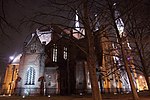Będzin

Będzin (Polish: [ˈbɛɲd͡ʑin] ; also Bendzin in English; German: Bendzin; Yiddish: בענדין, romanized: Bendin) is a city in the Dąbrowa Basin, in southern Poland. It lies in the Silesian Highlands, on the Czarna Przemsza River (a tributary of the Vistula). Even though part of Silesian Voivodeship, Będzin belongs to historic Lesser Poland, and it is one of the oldest towns of this province. Będzin is regarded as the capital of industrial Dąbrowa Basin. It has been situated in the Silesian Voivodeship since its formation in 1999. Before 1999, it was located in the Katowice Voivodeship. Będzin is one of the cities of the 2.7 million conurbation - Katowice urban area and within a greater Silesian metropolitan area populated by about 5,294,000 people. The population of the city itself as of December 2021 is 55,183.Będzin is located 12 km (7 mi) from Katowice and 4 km (2 mi) from the center of Sosnowiec. Together with Sosnowiec, Dąbrowa Górnicza, Czeladź, Wojkowice, Sławków and Siewierz it is a part of Zagłębie Dąbrowskie, a highly industrialized and densely populated part of western Lesser Poland. Będzin borders the cities of Sosnowiec, Dąbrowa Górnicza, Czeladź, Siemianowice Śląskie, and Wojkowice, as well as the village of Psary. The highest point of the town is St. Dorothy Mountain 382 m (1,253 ft) above sea level, and the area of Będzin is 37.37 km2 (14.43 sq mi).
Excerpt from the Wikipedia article Będzin (License: CC BY-SA 3.0, Authors, Images).Będzin
Królowej Jadwigi,
Geographical coordinates (GPS) Address Phone number Nearby Places Show on map
Geographical coordinates (GPS)
| Latitude | Longitude |
|---|---|
| N 50.333333333333 ° | E 19.116666666667 ° |
Address
Domowe Przedszkole II
Królowej Jadwigi 2
42-500 , Gzichów (Gzichów)
Poland
Open on Google Maps







